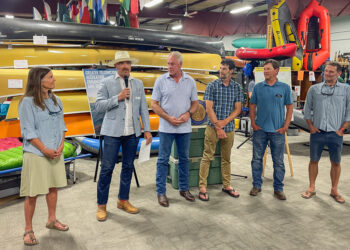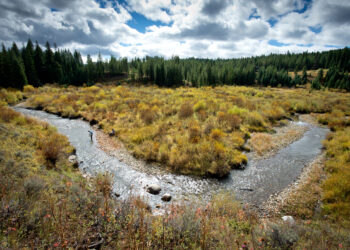By Benjamin Alva Polley EBS COLUMNIST
Years ago, two friends and I were hiking in the far northwestern corner of Glacier National Park. It was early November. Western larch trees were in full molt with butterscotch yellow robes draped and marching across hillsides and ridges west of the Continental Divide. Their needles gingerly fell from towering trees and lined the trails like a golden-brick road. The forests were luminous conifers brighter than sunshine at this time of the year as the sun was slipping to its southern house in the sky. There was no brush, as lightning struck the ground periodically and thinned the understory. The trunks of the trees were blackened and seasoned by fire’s regularity.
We were deep in conversation when I looked over my shoulder and saw a beautiful black wolf with golden-yellow eyes trotting along behind us. We stopped as the wolf continued along off-trail. She went within 10 feet of us. Something transpired between us as she stared into our souls, and we stared in awe at this preternatural opportunity. She leaned back on her haunches, marking some tall, tawny grass with her scent before continuing around us and slipping over the ridge out of sight. Some howls in the distance greeted her, she reassured them we were no threat, and she and the moment were gone.
Many people hear the word “wolf” and think of Yellowstone National Park’s reintroduction efforts and blame the federal government for trapping and releasing Canadian wolves into the states, but this is only part of the story. Recovery started decades before federal government agents reintroduced wolves simultaneously in Yellowstone National Park and Idaho’s Frank Church—River of No Return Wilderness in the winters of 1995 and ’96.
Yes, the Yellowstone story received the most headlines from the media and spoke the loudest. But the true story came in on long legs and giant paws as one or two wolves stole silently across the Canada-U.S. border to northwestern Montana in the late 1970s and early ‘80s, with barely any journalists covering it. They recolonized the Lower 48 states mostly by their choice and free agency.
Historically, northern gray wolves ranged from the Pacific Ocean to the Atlantic and from Mexico to the Arctic. During the “Manifest Destiny” period, settlers and fur traders hunted them to near extinction with guns, poison and steel. Now, they have made comebacks to Montana, Idaho, Oregon, Washington, Wyoming, California, Colorado and northern parts of Minnesota, Michigan and Wisconsin—but they still inhabit less than 10% of their former range. Wolves have traveled like spokes from the hubs of Glacier, Yellowstone and Idaho.
In 1978, wolves were listed as threatened under the Endangered Species Act. Wolves began trickling, on their own, across the Canadian border into northwestern Montana in the late ‘70s and early ‘80s. The first western wolf to be collared was a female in 1979 called Kishinena. At the time, wolf ecologists and University of Montana biologists began seeing her tracks in the snow accompanied by a larger male who only had three toes on one paw, probably caught in a trap. Kishinena’s radio collar died, but people continued seeing a wolf with a collar for the next year or so. These two wolves mated, then she denned just north of the Canadian border and had seven pups that April. Not long after, though, her mate was inadvertently snared in a trap and killed. She successfully raised all seven pups by herself. Wolf Ecology Project personnel continued to see tracks of eight wolves the following winter roaming the Flathead Valley. Years later, the descendants of those pups formed the first known pack to den inside Montana’s Glacier National Park in the early ‘80s. University of Montana wildlife biologists dubbed this pack the “Magic Pack.” There had been no breeding population of wolves in Glacier National Park from the 1930s until 1986, although occasional dispersers were reported.
Wolves’ controversial nature
While a subset of wildlife junkies felt wowed by what the return of these creatures meant for this ecosystem, the storied love-hate relationship between humans and wolves goes deep and is long-standing; during the 19th and early 20th centuries, wolves had been extirpated from much of their historic range throughout North America by intensive human efforts and the Predator Control Program, now called Wildlife Services. Montana’s wolf eradication efforts were complete by the 1950s, although a few individuals were killed in the next few decades. In the ‘60s and ‘70s, occasional wolves continued to steal across the boundary from southwest Alberta and southeast British Columbia. The wolves and other large carnivores like grizzlies, wolverines, lynx, and mountain lions follow a vital and broad landscape corridor of animal migration called Yellowstone to Yukon or Y2Y, allowing them to travel from Alberta and BC along the northern Rockies into Montana.
If you’re a wolf trotting down the toward Montana, you’ll still need to navigate the “smoke a pack a day” bumper stickers on trucks along the way, as well as plenty of “shoot, shovel, shut up” scowls at the end of scopes. Fearing the big, bad wolf, Little Red Riding Hood comes in all sizes and genders. Many local ranchers have the above mentality when seeing a wolf around livestock. Some hunters hate wolves and might say they kill all of “our” elk. In actuality, what wolves do for elk is ultimately increase their health and population; wolves keep ungulates from sitting around and being lazy. The elk are now on the move and not overbrowsing vegetation, which has allowed vegetation to grow taller and conceal the elk and the wolves. Hunters must work harder to find elk that are on the move. Human impacts have also changed the landscape.
The first wolf studies focused on pack habits and behavior, their impact on the ecosystem, habitat, and anything else researchers could glean from this species that was anything but the big, bad wolf of old children’s fables. Many Montanans didn’t receive those scientific studies well.
In the 1990s, “Jane Goodall of Wolves” Diane Boyd helped lead many of these studies. She said in a recent phone call that “Most wildlife managers admit most wildlife management is about managing people. Montana FWP used to set the wolf quota in Montana to appease the wolf haters more than to cull the wolf population.”
Besides Glacier being a haven from humans for these wolves, the area had a few relatively mild winters in the years before the wolves returned, allowing prey populations to recover, including whitetail deer, elk and moose. Wolves don’t have an easy life and compete with humans, grizzlies, black bears, mountain lions, lynxes, bobcats and coyotes. Despite ample prey, the park staff and the public remained at odds about wolves. Changing the public’s attitude has taken much longer and is still much work. The information gained by studying the wolves has helped impart ecosystem insights that make the wolf’s place in this region understood.
One fear of those who denounce wolves is that they’ll take over the landscape. Yet, understanding basic wildlife principles assures that if a wolf population rises too high for the ecosystem, the wolves subsequently die off of starvation and disease. Wolves keep each other in check. Wolf packs keep other wolf packs from growing too big, as well. Their territories can be 100 to 1,000 square miles and are based on habitat and available food. The same holds for elk or any other wildlife population. According to Boyd, the winter of 1996 was a big winter that killed over 40% of the whitetail deer population in northwestern Montana. That following spring, many wolf pups died of starvation. Nature has a way of checking and balances with all species.
Glacier National Park and the Lower 48 went quiet again, but not for long, as wolf howls returned to pour over the landscape.
Dispersal of these wolves in the ’80s and ’90s occurred in four cardinal directions: north to Canadian National Parks and beyond; others moved south to the Missoula area (Ninemile Valley, Montana), Idaho, and the Rocky Mountain Front near Augusta, Montana.
“Glacier Park was the first point of colonization,” Boyd explained. “People need to remember that before wolves were introduced, there were something like 70 to 80 wolves already in northwestern Montana and moving towards Yellowstone. Two wolves were spotted near Yellowstone in the early ‘90s, two years before the introduction. One wolf filmed in the Hayden Valley by [Bozeman videographer] Ray Paunovich, feeding on a carcass with a grizzly bear and coyotes. Another wolf was shot immediately south of Yellowstone, near Fox Creek/Fox Park.”
These two wolves were the first in or around Yellowstone in over 60 years. Through DNA testing, biologists discovered that this wolf came from the Ninemile Valley, northwest of Missoula.
Seeing a wolf is an experience beyond magical, almost otherworldly, a gift. Within the years surrounding the return of wolves to Glacier, more and more people’s attitudes began to alter. More of the public began to trade out their idea of this animal as a devil for the realization that it belonged to, and was necessary to, the ecosystem’s health. As the bumper-to-bumper traffic years after reintroduction in Yellowstone will attest to, people feel awe at the chance to see a wolf in the wild. Since the reintroduction of wolves in Yellowstone in 1996, tourism skyrocketed, with people going there to see or hear wild wolves in the Lamar Valley, Slough Creek area.
“People think of Yellowstone wolves as being incredibly special. All wolves are special. I want people to think if they really cared about those Yellowstone wolves, they should care about Glacier wolves, the Bitterroot wolves, or the Trego wolves,” said Boyd. “It’s a misguided passion because just because you can see and photograph the Yellowstone wolves doesn’t make them more special than other wolves in the state or elsewhere. All the wolves live the same life in the state of Montana. They are born, have challenges, and survive or don’t; if they survive and are lucky, they become breeders and shape the future of ecosystems, their pack structure, and the whole population. They’re all important.”
Benjamin Alva Polley is a place-based storyteller with stories published in Outside, Adventure Journal, Popular Science, Field & Stream, Esquire, Sierra, Audubon, Earth Island Journal, Modern Huntsman, and other publications at his website www.benjaminpolley.com/stories. He holds a master’s in Environmental Science and Natural Resource Journalism from the University of Montana.














